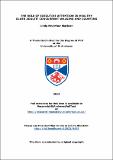Files in this item
The role of executive attention in healthy older adults' concurrent walking and counting
Item metadata
| dc.contributor.advisor | Astell, Arlene Jean | |
| dc.contributor.author | Maclean, Linda MacArthur | |
| dc.coverage.spatial | 214 | en_US |
| dc.date.accessioned | 2014-02-10T17:06:38Z | |
| dc.date.available | 2014-02-10T17:06:38Z | |
| dc.date.issued | 2013 | |
| dc.identifier.uri | https://hdl.handle.net/10023/4435 | |
| dc.description.abstract | Completing activities of daily life relies on using both cognitive and physical resources efficiently, but these are affected by age. This may be due either to an age-related reduction in the resources we have available for carrying out tasks or to a reduction in our ability to use these resources efficiently. These resources comprise a set of processes called executive functions (EF), which collectively allow us to plan, initiate and monitor our performance of activities. Control and allocation of these resources is attributed to a central mechanism, sometimes called the central executive or executive attention, but the parameters that determine how resources are allocated are not well understood. Even simple or apparently automatic activities, such as walking, require attention, meaning that when task demands increase, for example when walking and speaking on the phone, there is a loss of efficiency in both tasks. The dual-task (DT) paradigm is an empirical means of examining the way attentional resources are allocated between two tasks by comparing their performance together in relation to how well they are carried out singly. Asking people to perform a cognitive task, such as counting backwards or spelling, while walking provides a reasonably naturalistic way to examine how flexibly older adults can divide their attention between the two tasks. Manipulating the demands of the task, either by increasing the difficulty of the cognitive task or instructing the participants to focus on one task or the other (prioritisation) should illuminate the strategies they use to allocate their available attention between the two tasks ask task demands vary. To explore this hypothesis a cohort of physically and cognitively healthy community-dwelling older adults (mean age = 72.3 years) took part in three studies. In the first experiment, 72 participants completed 8 single and dual-task conditions with varying cognitive load (counting back in 3s and 7s) and attention prioritisation (no prioritisation, prioritising walking and prioritising counting). Instructing the participants to prioritise walking in the DT when counting back in 7s produced the best walking and counting performance and this was predicted their score on a standardised measure of cognitive flexibility. In second part of the study, 68 of the participants were tested 12 months later when there was improvement in both their single and dual-task performances. There was also decline in concurrent walking and counting performance, but only when attention was allocated to walking in preference to the cognitive task. Both the improvements and the decline in performance after the 12-month period were predicted by a standardised test for EF at T1. In the third study a separate group of older adults (73.2 years) was trained to walk rhythmically to music, to further investigate the external manipulation of resource-allocation during concurrent walking and counting. Their performances were compared to 2 control groups who did not receive the same intervention procedures. Overall findings from this doctoral research demonstrate that explicitly manipulating attention-allocation during concurrent walking and cognitive activity improved healthy older adults’ walking and counting performance and this was strongly associated with better cognitive flexibility. After 12 months, subtle decline in ability to allocate attention to walking during the DT, when attentional-demands were high, was also predicted by cognitive flexibility in an EF task. Together, these findings illuminated the role of executive attention in a rapidly-changing complex task when the ‘wrong’ prioritisation could result in a fall. Observing healthy older adults’ cognitive flexibility in allocating attention to walking, when required, revealed that executive attention was key to the future maintenance of their current functional well-being. | en_US |
| dc.language.iso | en | en_US |
| dc.publisher | University of St Andrews | |
| dc.subject.lcc | BF724.55.A35 | |
| dc.subject.lcsh | Executive functions (Neuropsychology) | en_US |
| dc.subject.lcsh | Attention | en_US |
| dc.subject.lcsh | Aging--Psychological aspects | en_US |
| dc.title | The role of executive attention in healthy older adults' concurrent walking and counting | en_US |
| dc.type | Thesis | en_US |
| dc.contributor.sponsor | Economic and Social Research Council (ESRC) | en_US |
| dc.type.qualificationlevel | Doctoral | en_US |
| dc.type.qualificationname | PhD Doctor of Philosophy | en_US |
| dc.publisher.institution | The University of St Andrews | en_US |
This item appears in the following Collection(s)
Items in the St Andrews Research Repository are protected by copyright, with all rights reserved, unless otherwise indicated.

